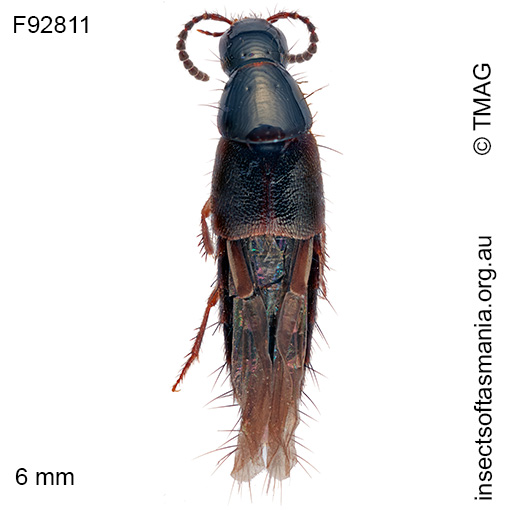
Quedius baldiensis Blackburn, 1891 (a species of rove-beetle)
Basis for Tasmanian occurrence
TMAG collections
Classification
Order: Coleoptera
Suborder: Polyphaga
Superfamily: Staphylinoidea
Family: Staphylinidae
Subfamily: Staphylininae
Tribe: Staphylinini
Morphology
Typical length (mm): 6
Flightedness: winged and assumed capable of flight
Source literature on morphology and taxonomy (*primary taxonomic source, where identified):
*Blackburn, T. (1891a). Further notes on Australian Coleoptera, with descriptions of new genera and species: IX. Trans. Roy. Soc. S. Aust. 14: 65-193.
Ecology
Assumed larval feeding: predator
Association with dead wood or old trees: at least facultatively saproxylic
Ecological attributes: — May occupy logs or trunks of Eucalyptus obliqua, at least temporarily, since found having emerged within a year of felling (Grove & Bashford, 2003) — May occupy logs or trunks of Eucalyptus obliqua, at least temporarily, since found having emerged within six years of felling (Grove et al., 2009).
Collection method(s) for TMAG material: — Baited trapping (funnel trap) — Emergence trapping from log of Eucalyptus obliqua — Hand collection (substrate not specified) — Knockdown fogging of canopy of Acacia melanoxylon — Knockdown fogging of canopy of Eucalyptus obliqua — Malaise trapping — Pipe trapping — Pitfall trapping — Vane trapping.
Source ecological literature:
Grove, S.J. & Bashford, R. (2003). Beetle assemblages from the Warra log decay project: insights from the first year of sampling. Tasforests 14: 117-129.
Grove, S. et al. (2009). A long-term experimental study of saproxylic beetle … succession in Tasmanian Eucalyptus … logs… In: Fattorini, S. (Ed.), Insect Ecology and Conservation. Research Signpost, pp. 71-114.
Grove, S.J. & Yaxley, B. (2005). Wildlife habitat strips and native forest ground-active beetle assemblages in plantation nodes in northeast Tasmania. Aust. J. Entom. 44 (4): 331-343.
Yee, M. (2005). The ecology and habitat requirements of saproxylic beetles native to Tasmanian wet eucalypt forests: potential impacts of commercial forestry practices. PhD thesis, Univ. of Tasmania, Hobart.

